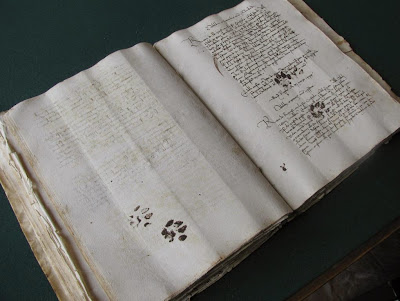Your job is boring and repetitive. You ache to express
yourself. The only way you can do this is to wait until your supervisor isn’t
looking – and doodle on your notepad. Well, this is equivalent to the medieval
monks who laboriously copied out manuscripts by hand – and added small drawings
of their own invention in the margins.
 |
| Cats will be cats as in this marginalia illustration |
Perhaps the cats that inspired these drawings in the
margins (or “marginalia”), also kept the monks company. As the monks drew, so
these felines worked alongside, keeping down the rats and mice. This was big
problem for the monks because the vermin were attracted to the paper which they
ate – destroying all that painstaking work. But the vermin were also bold, and
climbed the desks where the scribes worked and stole their food.
“Most wretched
mouse, often you provoke me to anger. May God destroy you!”
[Caption from a humours illustration of a Hildebert, a 12th century scribe, as he tries to catch the mouse that steals his cheese.]
 |
| Another cat doing what cats do. Clearly this scribe was bored |
But let’s face it many medieval monks did match the psychological
profile of a typical cat lover as creative and intelligent. However, one writer
was left his cat’s autograph when the cat stepped in ink and walked across the
manuscript.
 |
| A cat with wearing what appears to be a prototype jet pack |
Perhaps another scribe who was perhaps less pleased by
his cat’s “signature” was the one who returned in the morning to find a page
soaked in cat wee. He was forced to leave that page blank with a message to the
effect that nothing was missing but he’d learnt a lesson not to leave books out
at night.
 |
| Medieval paw prints captured in ink |
We know at least one Irish monk welcomed his feline
companion. He even gave the cat a name, Pangur Ban, and wrote a rather sweet
poem about him:
I and Pangur
Ban my cat
Tis a like
task we are at:
Hunting mice
is his delightful
Hunting words
I sit all night
 |
| This scribe was not a cat lover by all accounts |
What is interesting is that whilst cats were valued as
mousers, they were also feared as devilish creatures. Indeed, cats were widely
used elsewhere in medieval carvings and paintings, to tell ordinary folk cautionary
tales of good and evil – where the cat was portrayed as a cunning trickster.
Hmmm, I suppose cats have at least got their own back in the 21st
century, with life on their terms.
 |
| Widget- very much a 21st century cat |

What can I say. Meow?
ReplyDeleteLove your posts, Grace!
Awh, thank you Debra.
DeleteSo glad you enjoyed the post and thanks, as ever, for visiting.
G x